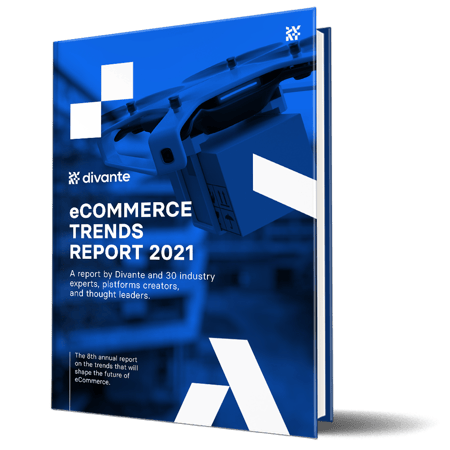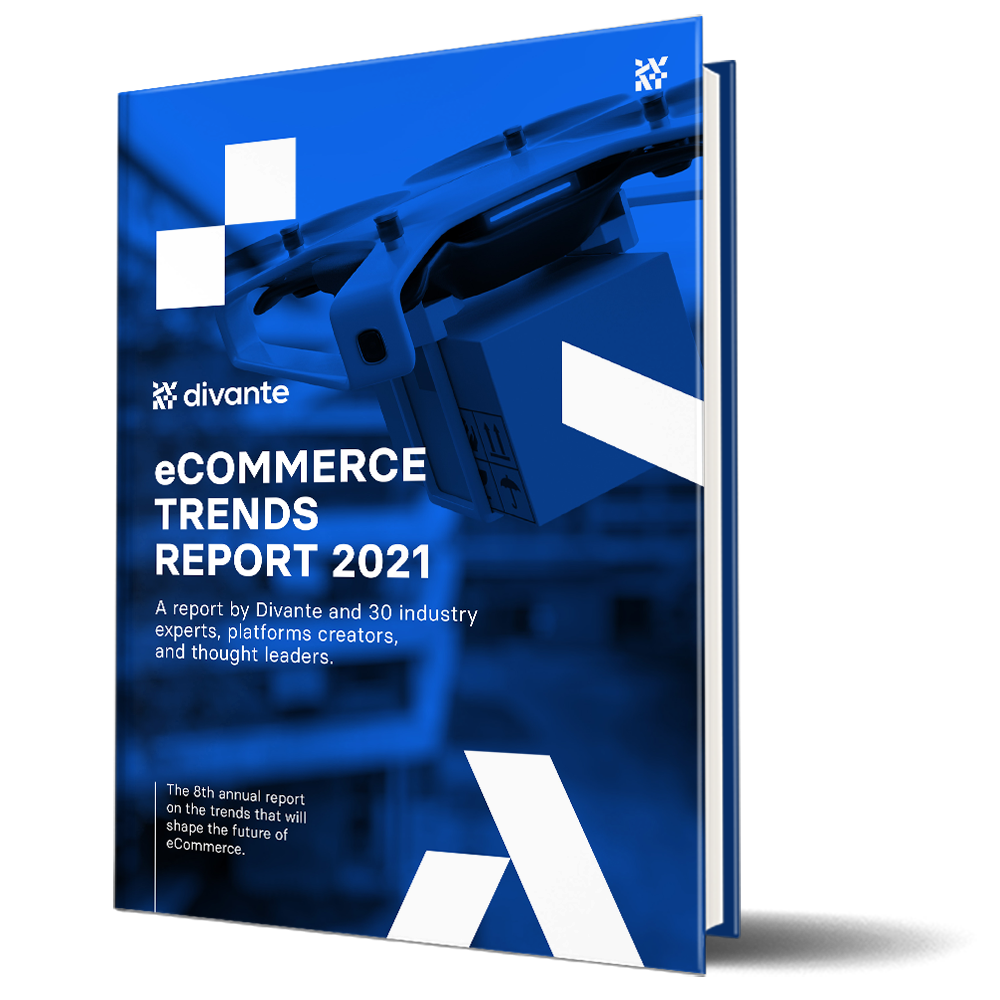-

TOP TRENDS
-

EXPERTS
-

PAGES
2020 has been a unique year, and 2021 is another step into the unknown. The only thing we can say for certain is that the age of eCommerce has truly arrived. As the relevance of statistics changes with the dynamic global situation, this year’s eCommerce Trends Report takes a fresh approach in uncertain times. We’ve pulled together leading voices from around the industry to share their thoughts on the trends of today and tomorrow.

KEY FINDINGS
-

MARKETPLACES ARE BOOMING
Traditional single-brand “online stores” are now only part of the go-to-market strategy for brands. Multi-vendor marketplaces and social commerce are where customers are also discovering and buying products
-

LOOK TO AI AND SOCIAL COMMERCE
AI and social commerce were identified as the trends that have gained the most traction in the last year and will be vital in 2021
-

MOBILE APPS DON’T BRING ROI
Mobile apps have lost all traction in eCommerce and are now being fully replaced by PWA sites
-

DATA IS KING. AND SO IS DATA PROTECTION.
Information is now king as AI and Big Data appear in the top 5 trends. Protecting that information is more important than ever as the global pandemic has opened up new vectors for cyberattacks
-

CRYPTOCURRENCIES ARE OUT
Cryptocurrencies were overwhelmingly judged as having made little progress in the eCommerce domain

“When all else failed, eCommerce was there. The events of 2020 could not have been foreseen but they accelerated change and it is clear that the tipping point has now been reached. Those last people who held out against online shopping have been onboarded and most have stayed after seeing the benefits.”
Tomasz Karwatka, CEO and Co-founder, Divante
ECOMMERCE TRENDS FOR 2021
-

BIG MOVERS - the 4 trends that have gained the most traction in 2021
Security
Marketplaces
Artificial Intelligence
Social commerce
-

KEEP FOCUS - stable trends that still represent a win for business
Big data
Mobile payments
Content marketing
Augmented Reality
-

CAN'T IGNORE - newcomers to the Top 12 which businesses need to assess right now
Interactional commerce
Headless architecture
as-a-Service models
Progressive Web Apps (PWA)
BIG MOVERS
-

Artificial Intelligence
Over half of our experts identified Artificial Intelligence as being more important than ever as we enter 2021.
Read moreAI was one of the two trends pinpointed as having gained significance in 2020. It’s linked to trends such as Big Data, which was identified as an area in which eCommerce businesses need to keep focus in the coming year. AI is the way in which brands can use data to learn more about customers and continuously refine and improve offers. It is the oil in the engine of hyper-personalization, as brands start to treat buyers as true individuals and not just as personas.
SaaS services make AI tools more readily available and usable for businesses of all sizes. However, more than any other trend, we heard the counter-argument that AI technology has perhaps reached a plateau, and while personalization and recommendations are a neat trick, we are yet to see the next great use cases that make it a truly transformative technology. -

Social commerce
Sell to you customers where they already are. With half a dozen apps accounting for most of the time people spend online, sales should be enabled straight in their interfaces.
Read moreFor better or worse, we are the Facebook generation. We are the Snapchat generation. We are the generation in which communal houses full of Tik Tok influencers entertain tens of millions of social media users for hours every day. Social platforms have kept people connected and entertained during a year of enforced isolation. Businesses have long been focused on having a strong social media presence to drive customers from their preferred platforms to online stores. However, the end goal has always been to cut out that click. Allowing users to buy directly on social media is a win-win-win. It keeps people on the social media platform, lets shoppers make faster sales decisions, and helps retailers to increase conversion and impulse buys.
-

Security
Data is king but so is data security. The pandemic has opened up new opportunities for online business but also created new paths of attack for malicious hackers.
Read moreSecurity has always been among the top priorities for online retailers. They now face new challenges on a number of fronts. Firstly, AI and Big Data are essential tools to leverage in order to beat out fierce competitors and create more personalized experiences, but all of that data needs to be kept secure. What’s more, users now interact with stores across a number of devices and touchpoints, each of which requires a separate frontend and could be a potential attack channel if not properly built. Meanwhile, hackers are constantly innovating and are using the pandemic as an opportunity for malicious activity.
Brands can no longer afford to see security as an afterthought, especially as it directly influences purchase decisions. 76% of online customers consider it a top priority when deciding where to buy. Trust is at the center of brand relationships. And security is how trust is built. -

Marketplaces
Another trend highlighted by over half of our experts. Marketplaces were already the world’s largest online businesses. And now they have gained ever greater power.
Marketplaces are such an integral part of all buying journeys that we perhaps even take them for granted. For example, stats show that 90% of people visit Amazon to compare prices before committing to an online purchase. Even if we do not convert through the marketplace every time, it is still key to our purchase decision.
In 2020, as high street stores closed, marketplaces become even more powerful. Small retailers without a robust online presence turned to marketplaces to generate quick sales and even save the business. 2021 will see more of the same, but it will also see the continued rise of a second powerhouse. B2B marketplaces are transforming traditional sales models and so believe they currently have even more potential than the retail model we know so well.
KEEP FOCUS
-

Big data
Still holding firm in our eCommerce Trends. Data lies at the heart of digital transformation and is the gateway for more advanced technologies like AI, Machine Learning, and Deep Learning.
Read moreFast-growing mobile data traffic, cloud computing traffic, and the development of technologies like artificial intelligence (AI) and the Internet of Things (IoT) all contribute to the increasing volume and complexity of data sets. The launch of 5G will also result in more interconnectivity and data sharing than ever before.
Advanced analytics tools, such as predictive analytics and data mining, will let eCommerce companies extract high-quality data to better understand their business and user needs. New data sources and improvements in data literacy levels will lead to the generation of new business insights. -

Mobile payments
As more and more time is spent on mobile, users don’t want to leave their preferred devices to complete transactions. Secure, at a click, and easy to use mobile payments are a focus for online retailers.
Read moreLast year, we discussed how 37% of global internet users pay for goods or services through mobile devices each month. Apple Pay, Samsung Pay, Android Pay, and PayPal are the most popular mobile wallets in the western world. Retailers like Walmart or Starbucks also offer separate mobile wallets. Asian customers can choose GrabPay, WeChat Pay, Line Pay, or Alipay among others.
Mobile payments are vital to helping close the mobile gap, whereby customers browse on mobile but switch to desktop devices to complete online sales. This is partly due to checkout processes being easier to handle on larger screens and with keyboards. But it is also because many customers are unfamiliar with mobile payments and these options still have to win the trust of online shoppers. But it is happening, and it is moving at speed. Mobile payments were one of the strongest mid-field performers in this year’s Trends Report. -

Content marketing
Content marketing is one of the most stable trends on our list. High quality, engaging content is the best way to attract customers.
Read moreContent marketing goes hand in hand with content management. A quality CMS solution is a vital tool for retailers to take brand messaging further and use content as a start point for customer relationships.
Another reason for strong content marketing is the usage of ad-blocking tools by almost half of internet users. Content must be displayed where customers are naturally viewing the web. As we observe a shift towards private digital spaces, we need to think of new content forms that create important, interesting, and timely relations with users, rather than filling endless content calendars.
As social commerce grows in importance, short video formats and cooperation with influencers become vital to all online retailers in that space. -

Augmented Reality
Over 100 million customers have already bought AR products but how is it bringing added value to the eCommerce domain? A technology on the bubble.
Read moreWe removed and replaced 4 trends from 2020 with new ones for 2021. Augmented Reality just escaped the cut. Our experts were evenly split about its relevance as we go into 2021 and so the year ahead will be a critical one as AR companies need to prove that their technology brings genuine value and incredible conversion in a challenging economic climate. Some still see AR as a gimmick, while others point to the fact that 63% of retail brands say they have already experimented and implemented AR solutions.
Social media apps like Instagram and Snapchat have been the pioneers but eCommerce is catching on and huge global brands like Nike and Converse have tried it on for size. Adding fun to buying journeys is a nice touch, but retailers live or die by their ability to convert interesting experiences into actual sales. This is where AR needs to start proving its worth.
CAN'T IGNORE
-

Interactional commerce
We’re creating an umbrella term for voice commerce, conversational commerce, video commerce, and other loosely-related technologies that our experts identified as being missing from previous lists.
Read moreWe have reached a point where we are comfortable interacting with interfaces and algorithms that react to our commands. When we add human assistance into the mix—in situations like B2B video sales calls or personalized, guided shopping with fashion sales reps—it becomes even more attractive. As businesses are forced online due to lockdowns and the squeeze on the high street, shoppers are looking for in-store-like experiences on digital channels. That means discussing products with bots or humans, as we go beyond just find-and-buy. Interactional commerce is where retailers can use technology and their sales experts to answer customer questions, help them overcome indecision, and change buying intent into positive conversion.
-

Headless architecture
Not every new trend on the list is a new technology. We are looking at importance, not only novelty value. Headless architecture is a proven win for eCommerce and the major shift taking place in the industry in the last two years.
Read moreeCommerce is about creating experiences that match or better those of in-store shopping. While we still can’t quite replicate the feeling of friends strolling together in a shopping mall as a social activity, we can match or improve any other part of the brick-and-mortar shopping experience. However, we can’t do it with monoliths. Clunky architecture worked in the early days of eCommerce but it is incapable of matching the current speed of change when there are so many interdependencies in the code.
What’s more, businesses need to understand how to deliver different front end interfaces on a range of devices where shoppers might be interacting with the store, from desktops to mobile to smartwatches and smart glasses. All eCommerce players are now in two categories: they are either ‘headless’ or ‘struggling to adapt’. -

as-a-Service models
On-demand, in the cloud, and pay-as-you-go-and-only-for-what-you-use. There are specific and powerful solutions for everything available in the marketplace. Companies can mix-and-match what works for their business and their budget.
Read moreWe’re not just talking about Software-as-a-Service. Everything from the technology we build to the people who build it can be purchased in pay-as-you-go-and-only-for-what-you-use models. The era of vendor lock-in and business contracts that tie companies down for years ahead is gone. as-a-Service solutions need to remain hungry, competitive, and attractively priced to keep customers in the longer term. It’s “survival of the best service”.
For large businesses, the as-a-Service model takes away the multi-million dollar cost of getting to an MVP. For smaller companies, it allows them to enter digital transformation and pay only what they can afford. The results should bring more profit, which can then be reinvested into the business and the next steps on the innovation trail. -

Progressive Web Apps (PWA)
Mobile apps are out. Long live PWA. Another technology that is not necessarily new but is transformative and deserves to be an eCommerce Trend for 2021.
Read moreAs Mobile Apps fall from the Top 12 trends, Progressive Web Applications are their natural replacement. That is not to say that mobile apps don’t have their place; for games, audio-video, and other data-hungry applications, they are still the best choice on mobile or other devices. However, in eCommerce, many retailers have found that the time and cost involved in creating an app do not pay off in terms of ROI.
The only way to win when customers have more choice is to be better than competitors, be available at all times, and allow people to convert mobile experiences easily and instantly. That means exploring PWA sites that load faster, lower bounce rates, and super-charge conversion.
MEET THE EXPERTS
-

Stefan Hamann
CEO and founder of shopware. Since founding the company when 16-years-old, Stefan has been responsible for defining the strategic course of shopware AG. With a focus dedicated to technology, finance and controlling, Stefan spearheads the continuing development of the award-winning eCommerce platform.
-

Kelly Goetsch
Chief Product Officer at commercetools, previously of Oracle and ATG. Author of four O’Reilly books, he gained a master's degree in Management Information Systems, and holds three patents, including one for distributed computing. President of the MACH Alliance, which promotes a Microservices, API-first, Cloud-native, and Headless approach to technology.
-

Adam Sturrock
Product Marketing Consultant & Solution Architect at Sturrock Ltd. Founder of Moltin, a headless eCommerce platform founded in 2013 and acquired by Elastic Path 2019, and Y Combinator Alumni. Also joined MACH Alliance as an Ambassador in 2020.
-

Craig Crook
Head of Growth & Innovation for INTO, a growth agency. He consults with business leaders across the U.S. to find the most relevant places to grow top-line revenue.
-

Mateusz Ostafil
SAP Spartacus Evangelist at Divante. Certified Spartacus trainer and contributor to OpenSAP courses.
-

Paweł Wiącek
Director of Solution Engineering, SAP Customer Experience. Digital transformation leader with 15 years of eCommerce and digital experience in various capacities on two continents. Currently leading SAP CX teams of solution experts in the Northeast and Midwest of the USA.
-

Tzipi Avioz
EVP of Customer Success for the Americas and APAC at Mirakl. More than 20 years of experience in digital commerce, data analytics, and the execution of large-scale digital transformation projects. Previously Head of Digital Commerce at Woolworths, Australia, and Technology & Operations Director for wealth management company AMP.
-

Damian Legawiec
Co-founder and CTO at Spark Solutions and Tech Lead of the Spree Commerce project, the most popular Ruby on Rails eCommerce engine, used by 45,000 eCommerce websites globally. In 2010, he founded GameTrade.pl, which raised two rounds of financing and garnered over 1 million visits per month, before exiting in 2014.
-

Patryk Zawadzki
Founder and CTO of Saleor Commerce and Head of Technology at Mirumee Software. A proponent of Python, GraphQL, and open-source technologies. Active supporter of women’s rights and the Django Girls organization.
-

Boris Lokschin
Serial entrepreneur and CEO at Spryker Systems, which is included in the Gartner Magic Quadrant for Digital Commerce 2020. Has built and scaled two previous companies that achieved successful exits to US-based global corporations.
-

Slavica Grgic
Content Editor and UX Researcher at SuperSuper Agency with a love of beautiful and useful design. Takes a creative approach to marketing through SEO research and high-quality copy.
-

Dominik Angerer
CEO of Storyblok GmbH. A web performance specialist and perfectionist. After working for big agencies as a full stack developer, he founded Storyblok. He is also an active contributor to the open-source community and one of the organizers of Stahlstadt.js.
-

Adam Willmouth
Director of Sales at Virto Commerce, which creates B2B digital commerce for enterprises. Helps organizations leverage state-of-the-art software, services, and processes to adopt the right capabilities to operate in a digital-first world.
-

Marie-Michele Larivée
Independent trends, strategy and foresight consultant. Tracks evolution and societal shifts translating it into aesthetics. She specializes in emerging mindset, youth culture (Gen Z and Y) and trend strategy alignment. A university lecturer teaching trend analysis and featured expert in Nylon, Business Insider, Sourcing Journal among others.
-

Moritz Spangenberg
Client Partner at Netguru. Creative digital strategist, business developer, and management consultant with a decade of experience and strong academic qualifications. Supports champions in the area of innovation, digital transformation, and growth.
-

Jakub Gierszyński
eCommerce and Marketing Director at Inter Cars S.A. Focused on collaborating business, technology and people to deliver omnichannel growth. Experienced in digital transformation of business environment and team building. Passionate of sharing knowledge especially during public speaking, workshops and networking.
-

Sascha Stockem
Founder and CEO of Nethansa, a company that offers services that increase sales on Amazon, and is a certified service and technology partner of Amazon. The originator of the Clipperon system that automates sales using artificial intelligence. Enabled over 50 million € in sales for customers in the last 2 years on marketplaces.
-

Jakub Chmielniak
Owner and partner of numerous startups within the eCommerce domain, including Lethe and Mr Gugu. Recent ventures include influencer marketing agency DDOB and eCommerce live-streaming app Corner.
-

Cezary Olejarczyk
CEO of Open Loyalty, the world’s first headless loyalty software that is dedicated to building loyalty programs for large-scale projects.
-

Patrick Friday
CEO and Business Founder of Vue Storefront. 8 years of experience working with various eCommerce startups, beginning at Vivino. His early career focused on native iOS and Android and then shifted to mobile Web and PWA technologies.
-

Yoav Kutner
Founder and CEO of Oro Inc. Previously CTO and Co-founder of Magento where he led product and technology development for all Magento offerings from inception until after its acquisition by eBay in 2011. Yoav is a proven product visionary in the business application market.
-

Matt Gorniak
CEO of Threekit, a software platform that enables companies to create 3D, photorealistic images, and augmented reality (AR) without the need for photography. Previously, founded G2 Crowd, the leading review platform for business software, read by over 1M tech buyers monthly. Previously of Salesforce, BigMachines Inc. and SteelBrick.
-

Ashley Dudarenok
Renowned China marketing expert recognized as a LinkedIn Top Voice in Marketing in 2019 and chosen as an Asia-Pacific Top 25 Innovator by the Holmes Report. She is the founder of China-focused social media agency Alarice and China insights and training company ChoZan.
-

Artur Wala
Head of Divante Innovation Lab which creates an environment for the discovery, design, and development of breakthrough eCommerce products.
-

Art Boyd
VP of Global Alliances and Partner Sales at Mirakl. He is responsible for building a global network of service and technology partners to enhance customers’ success. Prior to joining Mirakl, Art ran the global Solution Partner Program at Magento and held senior leadership positions at LivePerson, Oracle, and ATG.
-

Jim Herbert
General Manager for European operations at BigCommerce, a recognised global leader in the eCommerce space. Responsible for European P&L, sales, marketing, channel and continuing to develop the world class professional services and customer success capability to ensure BigCommerce merchants deploy and grow successfully.
-
.png?width=100&height=100&name=circle-cropped%20(3).png)
Tomasz Karwatka
CEO at Divante eCommerce Technology Company. Leading industry voice who believes eCommerce can improve our world. Co-founder of Vue Storefront and Open Loyalty, angel investor, and founder of Tech To The Rescue.
-

Piotr Karwatka
CTO at Divante eCommerce Technology Company. Open-source enthusiast and life-long builder. Co-founder of Vue Storefront and Open Loyalty. Now gathering engaged communities around new technologies.
-
%20(1).png?width=100&height=100&name=circle-cropped%20(4)%20(1).png)
Tamara Bolsewicz
Tamara Bolsewicz CEO and Co-Founder of Meetasales - seasoned creator of digital products with almost a decade of experience in the technology and eCommerce industry. Over the last years, she has co-created globaly used platforms and applications. Today she leads Meetsales - a platform that combines benefits of Zoom and Shopify.
-
.png?width=100&height=100&name=team_justyna_dzikowska_xsm%20(1).png)
Justyna Dzikowska
Head of Content at Divante. Digital Marketing expert, eCommerce trends observer and explorer. For the past 10 years dedicated to increasing visibility, sales, and ROI for global brands, digital products and agencies.
TOP ADVICE FROM THE EXPERTS

“Take a good, hard look at the strategic challenges you’ve uncovered in your business model
and your operating model this year—and treat them as the opportunities they are. New eCommerce leaders are being made now.”
Tzipi Avioz, EVP Customer Success, Mirakl

“Make sure that you are up to the technological challenges of the coming years and that you can easily and uncomplicatedly serve many different sales channels without operating too far out of your core competence. Focus strongly on projects and improvements that you can clearly control and measure.”
Stefan Hamann, CEO, Shopware

“It’s crucial to make your store available in all the places your customers are already spending their time, so choose a platform that integrates to social commerce and marketplaces to capture as much business as possible. Go live when your new site is better than your existing site, not when it’s perfect.”
Jim Herbert, VP & GM Europe, BigCommerce

“Speed and time-to-market matter more than ever. CVPs (Corona viable products) are the new MVPs. Composable enterprises are requesting packaged business capabilities in the cloud. Leverage those as efficiently as possible.”
Boris Lokschin, Co-founder and CEO, Spryker Systems
Download eCommerce Trends Report 2021



